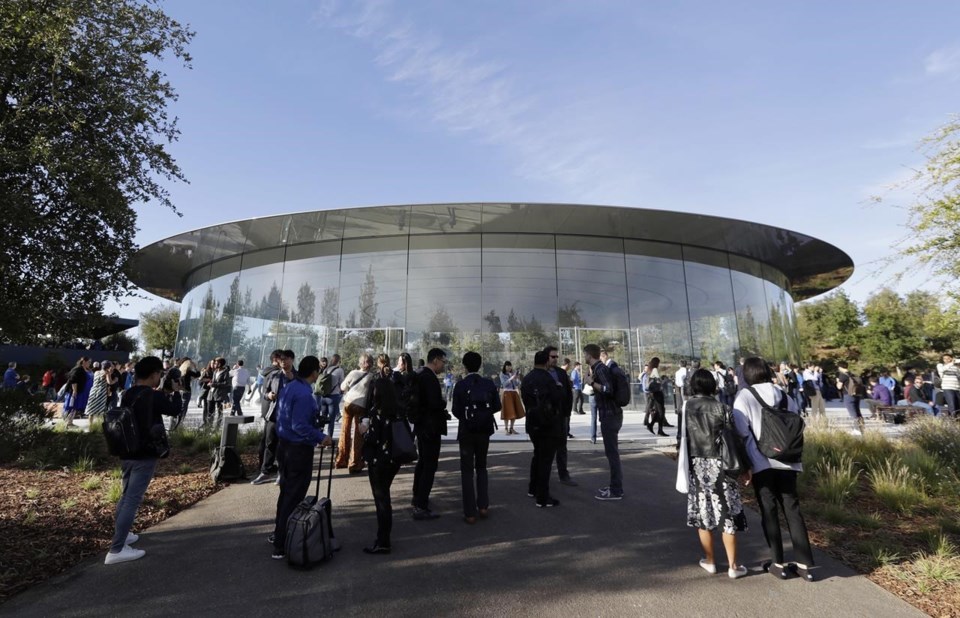CUPERTINO, Calif. (AP) — Apple on Monday unveiled a long-rumored headset that will place its users between the virtual and real world, while also testing the technology trendsetter's ability to popularize new-fangled devices after others failed to capture the public's imagination.
After years of speculation, Apple CEO Tim Cook hailed the arrival of the sleek goggles — dubbed "Vision Pro" — at the the company's annual developers conference held on a park-like campus in Cupertino, California, that Apple's late co-founder Steve Jobs helped design.
“This marks the beginning of a journey that will bring a new dimension to powerful personal technology," Cook told the crowd. Apple didn't immediately reveal the goggles' price, although they are expected to cost in the $3,000 range, likely limiting their appeal to a fairly narrow band of video-game enthusiasts and affluent technophiles.
The headset could become another milestone in Apple’s lore of releasing game-changing technology, even though the company hasn’t always been the first to try its hand at making a particular device.
Apple's lineage of breakthroughs date back to a bow-tied Jobs peddling the first Mac in 1984 —a tradition that continued with the iPod in 2001, the iPhone in 2007, the iPad in 2010, the Apple Watch in 2014 and its AirPods in 2016.
If the new device turns out to be a niche product, it would leave Apple in the same bind as other major tech companies and startups that have tried selling headsets or glasses equipped with technology that either thrusts people into artificial worlds or projects digital images with scenery and things that are actually in front of them — a format known as “augmented reality.”
Facebook founder Mark Zuckerberg has been describing these alternate three-dimensional realities as the “metaverse.” It's a geeky concept that he tried to push into the mainstream by changing the name of his social networking company to Meta Platforms in 2021 and then pouring billions of dollars into improving the virtual technology.
But , although Meta's virtual reality headset, the Quest, remains the top-selling device in a category that so far has mostly appealed to video game players looking for even more immersive experiences.
The response to virtual, augmented and mixed reality has been decidedly ho-hum so far. Some of the gadgets deploying the technology have even been derisively mocked, with the most notable example being Google's internet-connected glasses released more than a decade ago.
After Google co-founder Sergey Brin initially drummed up excitement about the device by demonstrating an early model's potential “wow factor” , consumers quickly became turned off to a product that allowed its users to surreptitiously take pictures and video. The backlash became so intense that people who wore the gear became known as “Glassholes,” leading Google to withdraw the product a few years after its debut.
Microsoft also has had limited success with HoloLens, a mixed-reality headset released in 2016, although the software maker .
Magic Leap, a startup that stirred excitement with previews of a mixed-reality technology that could conjure , had so much trouble marketing its first headset to consumers in 2018 that it has since shifted its focus to industrial, health care and emergency uses.
Daniel Diez, Magic Leap's chief transformation officer, said there are four major questions Apple's goggles will have to answer: “What can people do with it? What does this thing look and feel like? Is it comfortable to wear? And how much is it going to cost?”
The anticipation that Apple's goggles are going to sell for several thousand dollars already has dampened expectations for the product. Although he expects Apple's goggles to boast “jaw dropping” technology, Wedbush Securities analyst Dan Ives said he expects the company to sell just 150,000 units during the device's first year on the market — a mere speck in the company's portfolio. By comparison, Apple sells more than 200 million of its marquee iPhones a year. But the iPhone wasn't an immediate sensation, with sales of fewer than 12 million units in its first full year on the market.
Since 2016, the average annual shipments of virtual- and augmented-reality devices have averaged 8.6 million units, according to the research firm CCS Insight. The firm expects with a sales projection of about 11 million of the devices before gradually climbing to 67 million in 2026.
Before taking the wraps of its new goggles, Apple kicked off the event by announcing that the latest models of two high-end computer lines, the Mac Studio and Mac Pro, will be powered by a company-designed chip that has already been available in less expensive Macs.
The Mac Studio will sell for $2,000 and the Mac Pro will be priced at $7,000. As it typically does at this conference, Apple provided a peek at the next iPhone operating system, iOS 17. That software, which will include more personalization and location-sharing tools for phone calls and texting, is expected to be released as a free update in September.
Michael Liedtke, The Associated Press



